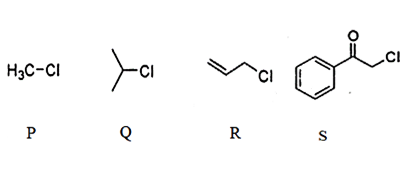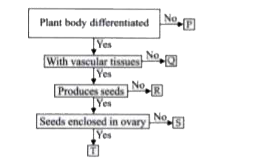The mechanism for the reaction is given below
2P+Q→S+T
P+Q→R+S (slow )
P+R→T (fast)
The rate law expression for the reaction is
r=k[P]2[Q]
r=k[P][Q]
r = k[A] [R]
r=k[P]2
The correct Answer is:b
To derive the rate law expression for the reaction given the mechanism, we will follow these steps:
Step 1: Identify the Rate-Determining Step
The rate-determining step (RDS) is the slowest step in the reaction mechanism. In this case, the slow step is:
P+Q→R+S
Step 2: Write the Rate Law Expression
The rate law expression is based on the rate-determining step. For the reaction:
P+Q→R+S
The rate law can be expressed as:
Rate=k⋅(P)m⋅(Q)n
where k is the rate constant, and m and n are the orders of the reaction with respect to reactants P and Q.
Step 3: Determine the Orders of the Reaction
Since the rate-determining step involves one molecule of P and one molecule of Q, we can assume that both m and n are equal to 1. Thus, the rate law expression simplifies to:
Rate=k⋅(P)1⋅(Q)1
or simply:
Rate=k⋅(P)⋅(Q)
Step 4: Final Rate Law Expression
Therefore, the final rate law expression for the overall reaction 2P+Q→S+T is:
Rate=k⋅(P)⋅(Q)
The rate-determining step (RDS) is the slowest step in the reaction mechanism. In this case, the slow step is:
P+Q→R+S
The rate law expression is based on the rate-determining step. For the reaction:
P+Q→R+S
The rate law can be expressed as:
Rate=k⋅(P)m⋅(Q)n
where k is the rate constant, and m and n are the orders of the reaction with respect to reactants P and Q.
Since the rate-determining step involves one molecule of P and one molecule of Q, we can assume that both m and n are equal to 1. Thus, the rate law expression simplifies to:
Rate=k⋅(P)1⋅(Q)1
or simply:
Rate=k⋅(P)⋅(Q)
Therefore, the final rate law expression for the overall reaction 2P+Q→S+T is:
Rate=k⋅(P)⋅(Q)
Topper's Solved these Questions
- CHEMICAL KINETICS BOOK - ERRORLESS CHAPTER - CHEMICAL KINETICS EXERCISE - Ordinary Thinking (Collision theory , Energy of activation and Arrhenius equation )
45 Videos
- CHEMICAL KINETICS BOOK - ERRORLESS CHAPTER - CHEMICAL KINETICS EXERCISE - Critical Thinking Objective Questions
20 Videos
- CHEMICAL KINETICS BOOK - ERRORLESS CHAPTER - CHEMICAL KINETICS EXERCISE - JEE (Advanced ) 2018
1 Videos
- CHEMICAL EQULIBRIUMBOOK - ERRORLESS CHAPTER - CHEMICAL EQULIBRIUMEXERCISE - JS JEE SECTION (ONLY ONE CHOICE ANSWER (Matrix)
1 Videos
- CHEMISTRY IN EVERYDAY IN LIFEBOOK - ERRORLESS CHAPTER - CHEMISTRY IN EVERYDAY IN LIFEEXERCISE - Critical Thinking (Objective question )
25 Videos
Similar Questions
Knowledge Check
The major product (s) of the following reaction is (are)

P Q
Q 
R S
S  APBQCRDS
APBQCRDSThe reaction , X+2Y+Z→N occurs by the following mechanism:
(P) X+Y⇔M (rapid equilibrium)
(Q) M+Z→P (slow)
(R) O+Y+P→N (very fast)
What is the rate law for this reaction?ARate =k[Z]BRate =k[X][Y]2[Z]CRate =k [N]DRate =k[X][Y][Z]$: P≥Q =R,S=T ≤V≥P
!:
I. P lt S
II. Q≤TAif only conclusion I is trueBif only conclusion II is trueCIf either conclusion I or II is trueDIf neither conclusion I nor II is true
Kl in acetone , undergoes SN2 reaction with each of P,Q,R,and S The rates of the reaction vary as

View SolutionPQRSTU is a regular hexagon. Determine each angle of PQT .
View SolutionWhat should come next in the following letter series ?
P Q P Q R P Q R S P Q R S T P Q R S T L P Q R S T U V P Q R S T
View SolutionThese questions are based on the information given below.
Six persons P, Q, R, S, T and U are sitting in a circle facing one another front to front. P is sitting in front of Q . Q is sitting to the right of T and left of R. P is sitting to the left of U and right of S.
Who is sitting opposite to R?
View SolutionThese questions are based on the information given below.
Six persons P, Q, R, S, T and U are sitting in a circle facing one another front to front. P is sitting in front of Q . Q is sitting to the right of T and left of R. P is sitting to the left of U and right of S.
Who is sitting opposite to S?
View Solution

